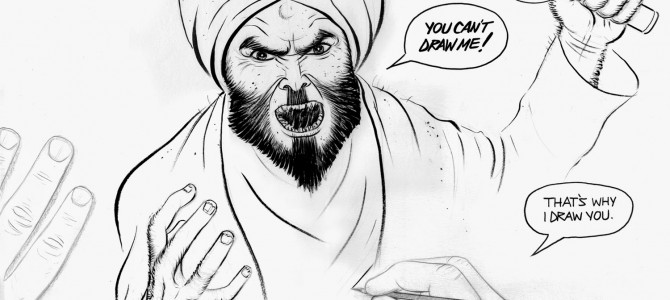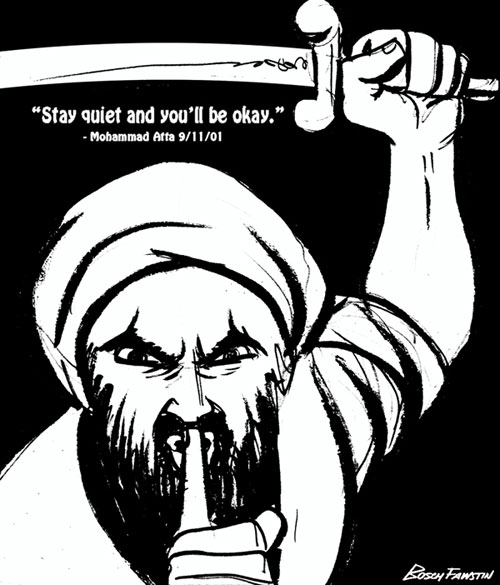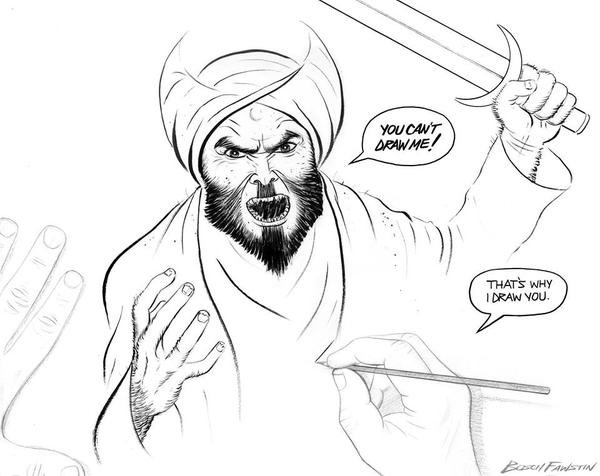
Over the weekend, “Saturday Night Live” took on the controversy over the Mohammed cartoon contest that was targeted by jihadists on May 3. But their sketch merely highlighted the weakness of the mainstream response.
It turns out, by the way, that this sketch had already been done by the Canadians. (And done better, I might add.) But hey, this is show business, right? Outright theft of material is the sincerest form of flattery.
That’s not the problem. Like many “Saturday Night Live” sketches, this one has a promising premise—a Pictionary-style game show in which the contestants are asked to draw “the prophet Mohammed”—but it goes nowhere. And the reason it goes nowhere is because it doesn’t have the courage to go anywhere.
The basic point of the sketch, which it draws out for more than four minutes, is that people are terrified of drawing Mohammed. Well, we already knew that. And the basic problem is that this fact is not funny. It is too painfully true.
This highlights one of the subtler problems with the mainstream response as the “cartoon jihad” comes to our shores. The non-subtle problem is the commentators who outright oppose the publishing of the cartoons and have openly given up on free speech. That’s a phenomenon I have already written about, and the Washington Post‘s Erik Wemple offers his own excellent round-up of “The Week That Cable News Failed Free Expression.” The only problem is that he limits himself to cable news, when the print and online media were furnishing plenty of other examples, from the New York Times to Bloomberg to the Washington Post itself.
Yet the subtler problem is with those who agree that the Mohammed cartoons are free speech and should be protected, and who want to express how much it makes them sad that someone would kill over a drawing—but who won’t even show us the drawings that the controversy is all about. They have decided that this is one controversy in which the public shouldn’t be encouraged to see the evidence and judge for themselves. This is one “provocative” issue on which they don’t really want to provoke anyone. So sure, they want to indicate their disapproval of a lethal prohibition on drawing Mohammed—but without doing anything to actually defy or weaken that prohibition.
That’s what gives these comments, like the “Saturday Night Live” sketch, the hollow feeling of a statement that doesn’t really state anything.
Do you want to take a stand in favor of free speech? Then I’m afraid you’re going to have to draw Mohammed. Or if you don’t possess that particular skill (and I sure don’t), then publish some of the cartoons that started this controversy.
Nearly a decade ago, after the first “cartoon jihad,” I argued for why this is necessary:
This is not merely a symbolic expression of support; it is a practical countermeasure against censorship. Censorship—especially the violent, anarchic type threatened by Muslim fanatics—is effective only when it can isolate a specific victim, making him feel as if he alone bears the brunt of the danger. What intimidates an artist or writer is not simply some Arab fanatic in the street carrying a placard that reads “Behead those who insult Islam.” What intimidates him is the feeling that, when the beheaders come after him, he will be on his own, with no allies or defenders—that everyone else will be too cowardly to stick their necks out.
The answer, for publishers, is to tell the Muslim fanatics that they can’t single out any one author, or artist, or publication. The answer is to show that we’re all united in defying the fanatics.
That’s what it means to show “solidarity” by re-publishing the cartoons. The message we need to send is: if you want to kill anyone who publishes those cartoons, or anyone who makes cartoons of Mohammed, then you’re going to have to kill us all. If you make war on one independent mind, you’re making war on all of us. And we’ll fight back.
So I was happy to see this same point reiterated recently by Mark Steyn:
[N]o cartoonist or publisher or editor should have to stand alone. The minute there were multimillion-dollar bounties on those cartoonists’ heads, The Times of London and Le Monde and The Washington Post and all the rest should have said, “This Thursday we’re all publishing the cartoons. If you want to put bounties on all our heads, you’d better have a great credit line at the Bank of Jihad. If you want to kill us, you’ll have to kill us all…”
Steyn, of course, has the courage of his convictions, so he includes an image of Bosch Fawstin’s winning cartoon from the Garland contest.
Simlarly, Eugene Volokh and the Washington Post get credit, not only for linking to Steyn, but for including an image of another Fawstin drawing, which is not explicitly of Mohammed but could definitely be interpreted that way.

As for myself, I’ve included the first Fawstin cartoon at the top of this article and below. And it’s not the first time. Back when my own newsletter still had a print version, this was our cover for the Danish cartoons controversy.

That’s Kurt Westergaard’s brilliant cartoon. The rest were published inside.
I don’t say this to boast about my great courage because I don’t think it takes great courage. Some other people who made it their business to be lightning rods have already made themselves the primary targets. I can publish these with confidence that before the jihadists go after me, they’ll go after Kurt Westergaard and Pamela Geller and Bosch Fawstin—by which I mean that they’ll go after them a second time—and then they’ll come for Geert Wilders and Mark Steyn. Eventually, they’ll come for me, but I’m a lot farther down the list. And anybody else who publishes it will have the privilege of going on the list after me.
But that’s the whole point: to spread out the danger by putting as many people on the list as possible.
This is why, despite all the throat-clearing about how such a provocation was unnecessary, Geller’s event was absolutely necessary and was the only way to make a real statement about free speech. Sometimes the only way to protect an endangered right is to exercise it. The only way to protest against a restriction on freedom of speech is to violate it. The imperative is summed up in Fawstin’s winning cartoon, in which the illustration of Mohammed declares “You can’t draw me,” and the artist replies, “That’s why I draw you.”

There are some actions which are unnecessary to do—until someone tells you that you can’t do them. And then you must do them, if only to retain your right to make your own decisions on the matter. It is not really important, for example, whether you sit at the front or the back of a bus—until someone tells you that you can’t sit at the front. It’s not worth risking your life to eat at a lunch counter or to cross a bridge—until some thug tells you that you can’t cross it. And then you must.
These are the kinds of stories the formerly “liberal” left has been trotting out for decades as an example of courage and high principles—but we’re finding out that it’s an example they won’t follow if it involves sticking their own necks out, or criticizing some culture other than the one they were lucky enough to be born into.
Yet the safety of silence is an illusion. Even if you don’t have the courage to do it, even if you want to offer an affirmation of free speech that is polite and toothless, this won’t save you. A typically execrable article at Salon contrasts Pamela Geller’s “hate speech” with an example of what they consider a better form of satire: Molly Norris’s 2010 cartoon calling for an “Everybody Draw Mohammed Day.” The difference? Geller was so gauche as to actually go out and host an event where everybody drew Mohammed. By contrast, Norris’s version of this idea was acceptable because she didn’t really mean it. She never actually drew Mohammed, she insisted that the suggestion was just a joke, and she cringingly apologized for it. The result? Norris is still living in hiding. She didn’t have the guts to commit the sin, yet she’s still paying for it.
In the end, what the jihadists really hate is not the actual act of violating their religious prohibitions. It’s your assertion of your right to do so. Which is precisely why you need to assert it as forcefully as possible.
If there were ever a case where the phrase “put up or shut up” applies, this is it. If you’re not actually publishing a drawing of Mohammed, you’re just pretending to be edgy, daring, and provocative—and you’re not really willing to take a risk and stand up for free speech.
Follow Robert on Twitter.









